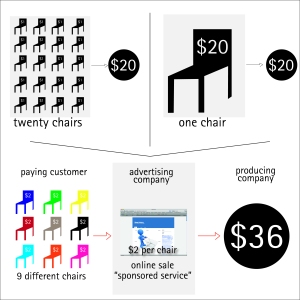Customizing customers
Recently, I read an article from designboom.com, in which they stated that ‘Philippe Stark rejects design art’; by one side, they say that Stark “rejects design activity that ‘wants to become art, but in fact is producing items’ – unnecessary and costly things”. I am sorry to evidence my lak of understanding of Mr. Stark saying this about this matters, but as I know an image speaks more than a thousand words…
By the other side, Mr. Stark states that he prefers to produce 100.000 chairs at a cost of 1 Euro, rather than 1 chair at the cost of 100.000 Euro; without mentioning his lack of consequence, being his design everything but affordable, I will have to disagree with that statement. First of all, producing 100.000 chairs is enviromentally irresponsible, needing besides to add an agresive campaign to merchandise and sell the chairs; second of all, that approach is typical from the industrial paradigm, in which the diversity of users was not an important variable, but now it is. I would like to state my disagreement in the claims made by Mr. Stark, allthough I have a giant respect and admiration for him.
Sure, design must not be exclusive nor costly, but that not necessarily means that it is a product that must be mass-produced and mass-merchandised. Design, in fact, has the power to create meaningfull and unique solutions for every person, but still being affordable; even though this may sound utopian there are few existing examples of this, like Nike ID, which lets every customer (wondering why they are called like that?) customize its own shoes and not necessarily pay a fortune; but the most relevant example lies in Internet advertising, which is the main reason why you can access almost any kind of information… for free! The reason why this is posible is because there is many companys paying so you can do that: in other words, they pay you to enter a site (google f.e) so you can pay them (google) for the service, just that you never see the money but you benefit from the service. This is the way Facebook and Google, which deliver a free product are able to be two of the most profitable companies in the world.
What would then be the scenario for this? Well, it is actually really simple to say, yet pending to see in action: where a company needs $100 profit, Stark proposes 100 chairs at 1$ each while other people propose 1 chair at $100; I say 20 unique chairs at $2 each and a $3 service behind that is being sponsored by big companies. Advertising must not affect the product or object, but any of the services that hide behind them. This is a way to apply the freeconomics speech that has been successfull in internet to the comerce of physichal products, where big companies pay through advertising so that you can get what you want at a low price.



